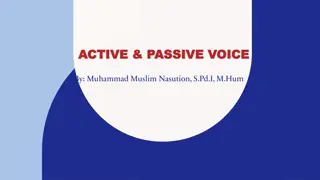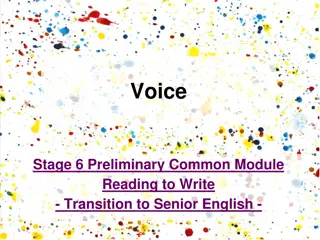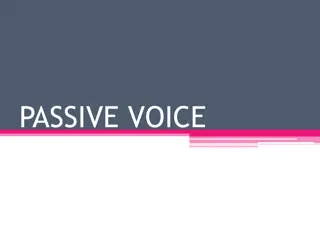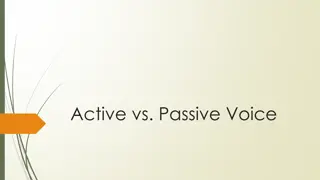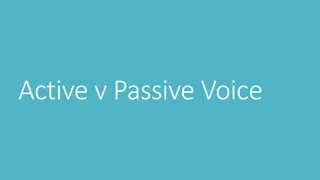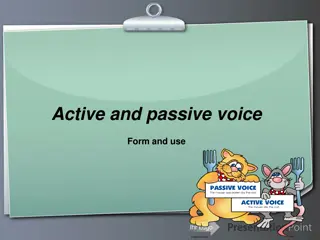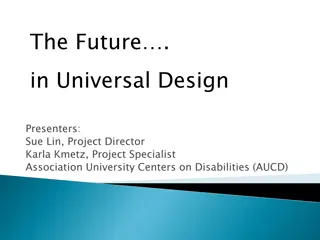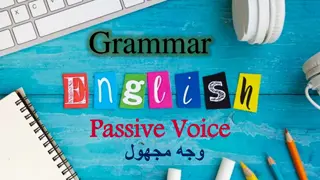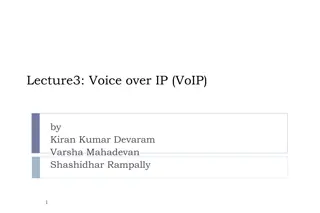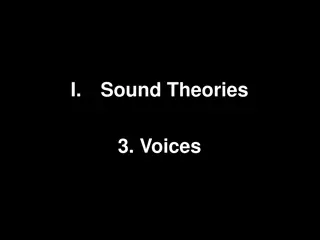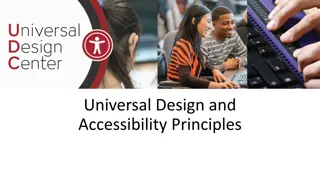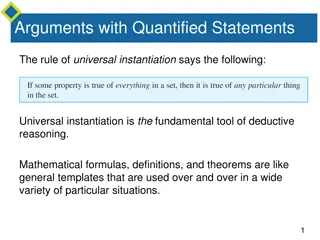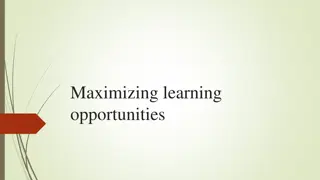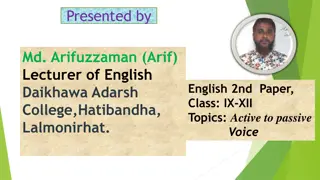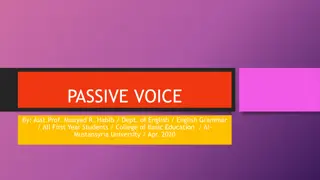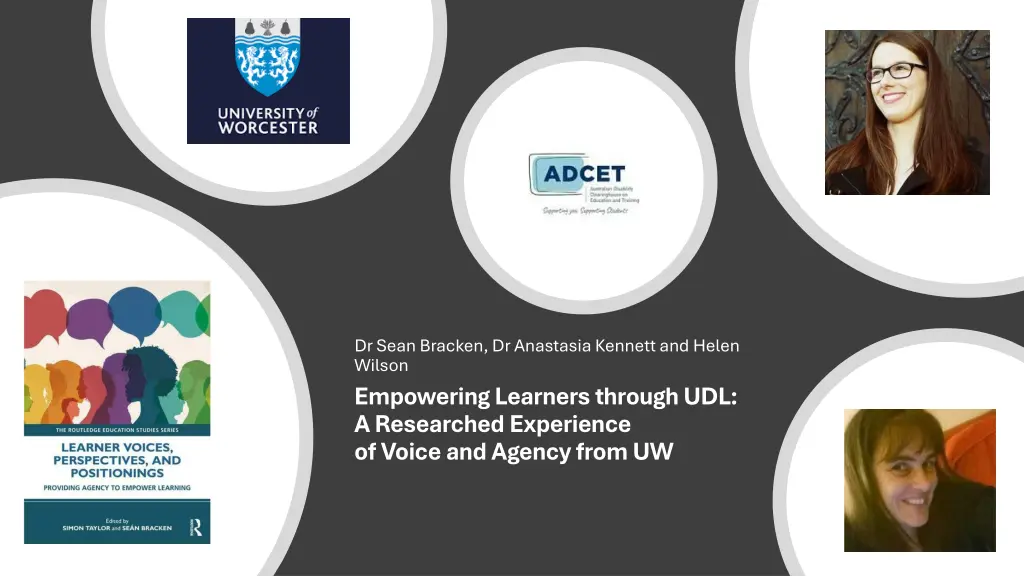
Empowering Learners through UDL Research
Explore the British Council-funded project on strengthening Higher Education in the UK and Indonesia through Universal Design for Learning. Discover the impact of learner voice and agency, with insights from Dr. Anastasia Kennett's research. Learn how co-construction with disabled learners and collaborative CPD modules aim to enhance educators' skills in UDL application.
Download Presentation

Please find below an Image/Link to download the presentation.
The content on the website is provided AS IS for your information and personal use only. It may not be sold, licensed, or shared on other websites without obtaining consent from the author. If you encounter any issues during the download, it is possible that the publisher has removed the file from their server.
You are allowed to download the files provided on this website for personal or commercial use, subject to the condition that they are used lawfully. All files are the property of their respective owners.
The content on the website is provided AS IS for your information and personal use only. It may not be sold, licensed, or shared on other websites without obtaining consent from the author.
E N D
Presentation Transcript
Dr Sean Bracken, Dr Anastasia Kennett and Helen Wilson Empowering Learners through UDL: A Researched Experience of Voice and Agency from UW
Centrality of learner voice Voice cannot be expressed without inclusion and inclusion cannot exist without voice - Messiou (2019)
Overview Provide an insight into the British Council funded project Strengthening Higher Education in the UK and Indonesia through UDL and posit LV at the heart of the process. Illustrate the profound impact that meaningful engagement with LV had on students, academics and the reform of curriculum. Complement the narrative with reference to Dr Anastasia Kennet s insights from her PhD heuristic inquiry research Explore and identify ways that LV might be explored within your settings.
Co-construction with disabled learners Gaining pre conference suggestions regarding what might work While bringing about change, individualised initiatives were less likely to be impactful, so formation of communities of praxis were encouraged to better facilitate cross-institutional alliances that could identify and address systemic barriers to engagement. Learner voice Pre-planning of Participation at a LV seminar and round table discussion Meta-analysis and co-writing of a chapter Co-construction of professional development UDL modules
Project aims (UI and UW) To collaboratively develop, pilot, and evaluate Continuing Professional Development (CPD) modules in Universal Design for Learning to help inform lecturers of the UDL framework, deepening knowledge and understanding to provide practice examples and actionable tasks to develop lecturers' skills in applying UDL
Learner perspectives Students had observed that: Students had observed that: Not all HE teachers were aware of what their needs might be and identified that training was an essential factor for fostering inclusion and belonging. There was a need to more beyond reasonable adjustments and provide valuable insights into students requirements, experiences and the impact of positive and negative practice from their perspectives. Having a voice literally became transformative firstly in terms of their own self worth and efficacy, while also transforming the perspectives that academics may have had of them, and it was facilitating a transformation of curriculum.
The importance of learner voice and agency Learner conference attendance and contribution Teachers and conference attendees gained valuable in-depth insight into learner experience (a key highlight fed back by attendees) Learner involvement with the collaborative workshops with UI and UW research team By using personal testimonies of students with diverse learning requirements, it enriched the transformative impact of future anticipatory inclusive design. The research team also learned from one anothers areas of strength in digital accessibility and learning to collaborate across a neurodiverse team Engaging students in the design and implementation of their educational experiences is essential for meaningful change.
Summing up: Two sides of the same coin: There are often inconsistencies between and student academic and student perceptions of the most effective UDL practices for promoting learning outcomes, highlighting the need for student feedback to better understand and plan for students needs (Varadhan et al, 2023) Serrano-Johnson (2020) suggests that constructive student feedback can be a catalyst for academics and professional services colleagues to better understand and integrate UDL into their teaching. Because the nature of student learning requirements were so diverse an increasingly comprehensive overview of requisite changes was revealed.
Book chapter Reference: Reference: Bracken, S Hopkins, A Kennett, A Lawrence, H Richardson, E Wedgbury, K & C. Wilson (2025) Empowering Disabled Learners Voices and Agency through Universal Design for Learning. In, Taylor. S. and Bracken, S., Ed.S (2025) Learner Voices, Perspectives, and Positionings: Providing Agency to Empower Learning. London: Routledge (forthcoming).
Using the learner voice and examples Key points highlighted in the chapter: Key points highlighted in the chapter: Learners with diverse learning needs (DLN) are experts by experience Learners with diverse learning needs (DLN) are experts by experience, they are the most fitting architects of their own learning design architects of their own learning design, but they require facilitative conditions of agency to realise their learning potentials. UDL provides a framework for inclusivity in learning environments, however this ought to be applied flexibly and is never a silver bullet responding to all students needs. Technology can play a significant role in enhancing learner agency Technology can play a significant role in enhancing learner agency. Policy changes are necessary to support inclusive education, and these should be meaningfully and agentively informed by the disabled learners experiences. Incorporating an international dimension to our educational experiences enables scope for widening our experiences and reflecting on our own cultural understandings of inclusion and accessibility for ALL learners.
Collaborative E-learning development The result of collaborative workshops The result of collaborative workshops with learners, teachers and with learners, teachers and researchers (visits) researchers (visits) Module authors: Dr Emma Richardson Helen Wilson (PhD student and Project Research Assistant) Astri Setiamurti from Universitas Indonesia The e-learning underscores the need to support the purposeful application purposeful application of the UDL principles to facilitate anticipatory inclusive design anticipatory inclusive design (Bracken, 2024).
FREE access to the E-learning Available in both English and Indonesian (Bahasa) English e-learning content Indonesian e-learning content The course consists of 4 brief modules that consist of: An introduction to Universal Design for Learning (UDL) Multiple means of engagement Multiple means of representation Multiple means of action and expression
Further insights from Anas PhD study of DLN 1. Needing a trauma- informed safe space to regulate emotions, 2. Removing judgement through implementing trauma-informed practice, 3. Embracing understanding and representation to enable authentic interaction, 4. Removing fear by humanising those in positions of power, and 5. Promoting choice and autonomy.
Representation of students AND staff By increasing representation of diverse staff members who may have greater empathy and who can draw on learned experiences meaningful partnership work with DLs can be promoted (Schley & Marchetti, 2022) Kennett 2025 Might this be a social actualization of multiple means of representation as shared in the UDL Framework 3.0?
Adopting a trauma informed approach The trauma-informed approach of enabling empowerment, voice, and choice (is) (USDHHS, 2014) a form of empowerment linked not only to being the voice of change but also to witnessing change (Ashton-Hay & Williams, 2023; Cook-Sather, 2022; Dollinger & Hanna, 2023; State Government of Victoria, 2024). Such empowerment can be achieved by enabling DLN students to practice using their voice and autonomy in making choices that matter to them (Brown et al., 2020; Dollinger & Hanna, 2023; Gillett-Swan et al., 2024). In turn, DLN students gain a sense of autonomy and agency that can help move them toward seeking and offering more partnership approaches to staff. Although partnership may not remove harm experienced by students in HE (Cook-Sather, 2022), partnerships that address the themes from this research could encourage diverse students to utilise their voice and move away from being silent (Ashton-Hay & Williams, 2023)
Meaningful voice making systems change Sensory guide to The Hive - Library Services QAA Student Panel: The Quality Assurance Agency for Higher Education (QAA) is an independent body which is responsible for safeguarding the standard and improving the quality of UK higher education.
Implications for my own role as a doctoral programme lead 1. Review institutional requirements for doctoral assessment preparation 2. Engage with inclusive assessment scholarship within teaching and learning to develop critical understandings of what inclusive PGR assessment might look like. 3. Provide universal accommodations 4. Increase awareness and visibility of disabled students and their requirements. 5. Enhance approaches to PGR supervision to account for Reasonable Adjustments and Mitigating circumstances ensuring these are in place from the outset and then checking in over the PGR cycle MADE REPORT
THINK, PAIR, SHARE (1, 2, 4) 15-MINUTE ACTIVITY Step 1:REFLECT make some notes for 3 minutes provide ONE suggestion for how learner voice is currently used within your setting. AND if this presentation sparked any new ideas, make an additional ONE suggestion regarding how you could better promote and extend diverse learner voice either within your organisation or extended to impact on regional, state, federal or transnational contexts. Step 2: Pair up and share 5 minutes Step 3: Pair with another pair and SHARE your ideas 5 minutes (collate your notes)
References and additional reading Ashton-Hay., S. & Williams, D. (2023). What student voice is and is not: Connecting dialogue to evidence-based practice and inclusive mindsets. Journal of University Teaching and Learning Practice, 20(6). https://doi.org/10.53761/1.20.6.1 Australian Council for Student Voice. (2024). Inclusive student voice toolkit. Australian Council for Student Voice Ltd. https://www.studentvoice.org.au/learn/resource-hub/inclusive-student- voice-toolkit Bracken, S Hopkins, A Kennett, A Lawrence, H Richardson, E Wedgbury, K & C. Wilson (2025) Empowering Disabled Learners Voices and Agency through Universal Design for Learning. In, Taylor. S. and Bracken, S., Ed.S (2025) Learner Voices, Perspectives, and Positionings: Providing Agency to Empower Learning. London: Routledge (forthcoming). Brown, K., de Bie, A., Aggarwal, A., Joslin, R., Williams-Habibi, S. & Sivanesanathan, V. (2020). Students with disabilities as partners: A case study on user testing an accessibility website. International Journal for Students as Partners, 4(2), 97 109. https://doi.org/10.15173/ijsap.v4i2.4051 Cook-Sather, A. (2022). Co-creating equitable teaching and learning: Structuring student voice into higher education. Harvard Education Press. Dollinger, M. & Hanna, L. (2023). Students with disabilities mentoring staff: Supporting scalableacademic development for inclusive education. International Journal for Academic Development, 1 3. https://doi- org.Apollo.work.ac.uk/10.1080/1360144X.2023.2262968 Dollinger, M. Rola, A., Finneran, R. & O Shea, S. (2023). Conceptualising responsibility and hostility within work-integrated learning placements for students with disabilities. Disability and Society, 39(9), 2217 2235. https://doiorg. apollo.worc.ac.uk/10.1080/09687599.2023.2209276 Fricker, M. (2010). Epistemic injustice: Power and the ethics of knowing (Repr). Oxford University Press.
References and additional reading Gillett-Swan, J. K., Willis, J., & Miles, P. (2024). Student wellbeing in vertical schools: A multilayered student voice approach for inclusion and influence.The Australian Educational Researcher. https://doi.org/10.1007/s13384-024-00765-6 Kennett, Anastasia (2025) Conceptualizing an inclusive approach to student voice in higher education: A heuristic inquiry. International Journal for Students as Partners. ISSN 2560-7367 Messiou, K. (2019). The missing voices: Students as a catalyst for promoting inclusive education. International Journal of Inclusive Education, 23(7 8), 768781.https://doi.org/10.1080/13603116.2019.1623326 Matthews, K. E. (2017). Five Propositions for Genuine Students as Partners Practice. International Journal for Students as Partners, 1(2), 1 9. https://doi.org/10.15173/ijsap.v1i2.3315 Schley, S. & Marchetti, C. (2022). Moving access to inclusion by making communication a priority: An inclusion mindset, Journal of Educational Innovation, Partnership and Change, 8(2). Retrieved from https://journals.studentengagement.org.uk/index.php/studentchangeagents/article/view/1 133 United States Department of Health and Human Services. (2014). SAMHSA s Concept of Trauma and Guidance for a Trauma-Informed Approach. https://store.samhsa.gov/product/SAMHSA-s-Concept-of- Trauma-and-Guidance-for-a-Trauma-Informed-Approach/SMA14-4884.html.
References and additional reading United States Department of Health and Human Services. (2014). SAMHSA s Concept of Trauma and Guidance for a Trauma-Informed Approach. https://store.samhsa.gov/product/SAMHSA-s-Concept-of- Trauma-and-Guidance-for-a-Trauma-Informed-Approach/SMA14-4884.html. State Government of Victoria. (2024). Student voice and disability inclusion. https://www.vic.gov.au/student- voice

